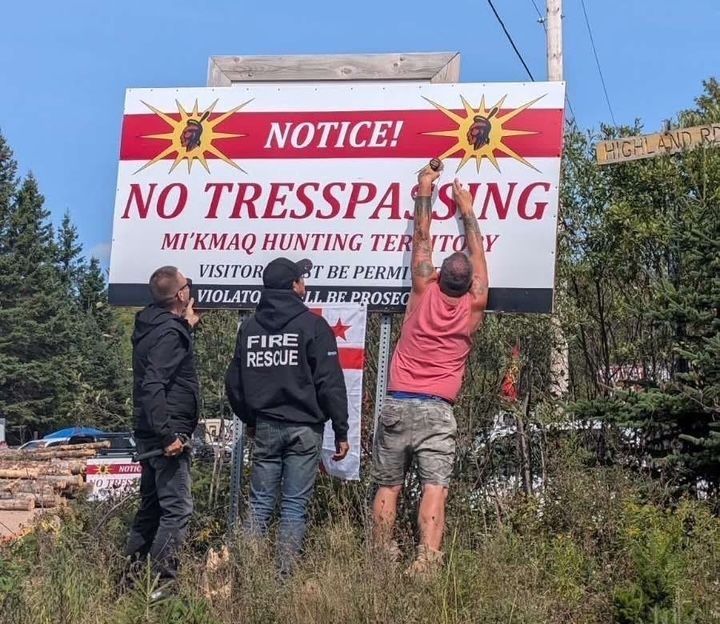Published Sep 27, 2025Last updated 3 hours ago12 minute readMi’kmaq protestors erect a sign on Hunters Mountain. Photo by Contributed /The Chronicle HeraldArticle contentDoes a treaty signed 273 years ago give the Mi’kmaq governance authority over all the land and water of Nova Scotia?THIS CONTENT IS RESERVED FOR SUBSCRIBERS ONLY.Subscribe now to access this story and more:Unlimited access to the website and appExclusive access to premium content, newsletters and podcastsFull access to the e-Edition app, an electronic replica of the print edition that you can share, download and comment onEnjoy insights and behind-the-scenes analysis from our award-winning journalistsSupport local journalists and the next generation of journalistsSUBSCRIBE TO UNLOCK MORE ARTICLES.Subscribe or sign in to your account to continue your reading experience.Unlimited access to the website and appExclusive access to premium content, newsletters and podcastsFull access to the e-Edition app, an electronic replica of the print edition that you can share, download and comment onEnjoy insights and behind-the-scenes analysis from our award-winning journalistsSupport local journalists and the next generation of journalistsRegister to unlock more articles.Create an account or sign in to continue your reading experience.Access additional stories every monthShare your thoughts and join the conversation in our commenting communityGet email updates from your favourite authorsSign In or Create an AccountorArticle contentThat’s what’s being claimed by a group of Mi’kmaq blockading access to the Cape Breton Highlands via Hunters Mountain for the past three weeks.Article contentArticle content“That’s why for a lot of Mi’maq today, our reverence for 1752 is that ongoing relationship to the treaty,” a Mi’kmaq lawyer who declined to give his name told The Chronicle Herald on Sunday at the barricade.Article contentArticle content“It’s an act of self-governance. In signing on to that treaty there’s basic rights our ancestors knew how to convey in English to say if you violate these rights we can no longer exist in peace and friendship with you and our people have tried desperately to live in peace and friendship with the government and the oligarchy that runs Canada for a very long time.”Article contentThe Treaty of 1752 was cited by then-Sipekne’katik First Nation chief Mike Sack when the band launched its self-regulated treaty lobster fishery on St. Mary’s Bay in 2020, and by the current chiefs of Sipekne’katik and Millbrook when they launched their own self-regulated elver fisheries this spring in defiance of Fisheries and Oceans Canada (DFO).Article contentOn Hunters Mountain, the blockade has shut down harvesting by Port Hawkesbury Paper, which is Cape Breton’s largest private employer, and caused Nova Scotia Power to stop all “non-emergency” work on a $110-million project ratepayers have already begun paying for to modernize and extend the life of its largest hydroelectric facility.Article contentArticle content Madonna Bernard, who goes by her Mi’kmaq name Kuku’wes, blocks a logging truck on Hunters Mountain. Photo by Aaron Beswick /The Chronicle HeraldArticle contentThe man at the blockade said that as industry had not received the Mi’kmaq’s “full, prior and informed consent” for harvesting and land clearing, they were exercising their right and responsibility for the area by shutting down activities there and blocking access to all but “treaty people.”Article contentArticle contentThe Treaty of 1752 has never been fully tested in a Nova Scotia court. But it may soon.Article contentOn Tuesday, Premier Tim Houston’s government introduced an omnibus bill (the Protecting Nova Scotians Act) that includes giving the Department of Natural Resources the authority to remove protestors who block forest roads on Crown land along with any structures they’ve erected, and slap them each with a $50,000 fine.Article contentIf the treaty ends up in court, the management of all Nova Scotia’s Crown land could hinge on the fate of the crew of an English sloop who were ambushed and killed in Jeddore 273 years ago.Article contentThe treatyArticle contentOn an early September morning in 1752, Jean Baptiste Cope paddled into Halifax Harbour.Article contentThe chief of some 90 Mi’kmaq, whose home hunting ground followed the Shubenacadie River up through a series of lakes to Musquodoboit, found a settlement afraid to leave its wooden walls.Article contentFounded three years earlier by Gov. Edward Cornwallis as an intended counter-balance to the French fortress at Louisbourg, Halifax was struggling. Established in violation of the commitment by the English to no new settlements in the Treaty of 1726, Halifax’s presence led to renewal of hostilities with the Mi’kmaq.Article contentThis led to raids on outposts in Dartmouth by combined Mi’kmaq and Acadian forces, supplied with arms by the French at Louisbourg.Article contentCornwallis had gone back to England, leaving his subordinate, Peregrine Thomas Hopson, in charge as governor. With soldiers fearful of venturing into the forest, Hopson was struggling to feed both his own colony and 300 Germans he couldn’t settle so long as there was war with the Mi’kmaq.Article contentArticle contentCope met with Hopson and his council and hashed out what would become the Treaty of 1752.Article contentThe mutual defence and trade pact saw Cope promise to attempt to bring other Mi’kmaq chiefs in to sign peace treaties, to ally with and aid the English against those who refused.Article content“That the said Tribe shall use their utmost endeavours to bring in the other Indians to Renew and Ratify this Peace, and shall discover and make known any attempts or designs of any other Indians or any Enemy whatever against His Majestys Subjects within this Province so soon as they shall know thereof,” reads Article 1 of the Treaty of 1752.Article content“And shall also hinder and Obstruct the same to the utmost of their Power, and on the other hand if any of the Indians refusing to ratify this Peace, shall make War upon the Tribe who have now confirmed the same; they shall upon Application have such aid and Assistance from the Government for their Defence, as the case may require.”Article contentArticle contentThe treaty promised that Mi’kmaq bands who also signed on would receive regular supplies of provisions and shot, and would have recourse in their dealings with settlers to the English courts where, promised Hopson, they would be treated equally.Article contentWhile those passages would be very relevant in the months to come, it was the treaty’s trade passage that has been quoted over recent years from the wharf in Saulnierville where Sipekne’katik launched its treaty lobster fishery.Article content Mike Sack, then-chief of the Sipekne’katik First Nation, announces the launch of his community’s treaty fishery on Aug. 16, 2020. Photo by Aaron Beswick /THE CHRONICLE HERALDArticle content“It is agreed that the said Tribe of Indians shall not be hindered from, but have free liberty of Hunting & Fishing as usual: and that if they shall think a Truckhouse needful at the River Chibenaccadie or any other place of their resort,” reads Article 4.Article content“They shall have the same built and proper Merchandize lodged therein, to be Exchanged for what the Indians shall have to dispose of, and that in the mean time the said Indians shall have free liberty to bring for Sale to Halifax or any other Settlement within this Province, Skins, feathers, fowl, fish or any other thing they shall have to sell, where they shall have liberty to dispose thereof to the best Advantage.”Article contentThe Treaty of 1752, along with a series of Supreme Court of Canada decisions, was cited by the chiefs of Sipekne’katik and Millbrook in letters sent to DFO elver review co-ordinator Jennifer Ford in March as evidence that the federal government had no authority over their self-governed fisheries for juvenile American eels (elvers).Article contentLarge notices with the ornate royal crest known as broadsides were sent to English forts telling of peace with Cope’s tribe and warning settlers to “forbear hostilities” against them.Article contentDays after its signing, Hopson wrote the London Board of Trade, stating he had made peace “with one tribe of the Mickmack Indians; tho it is but a small tribe I hope it may have the good effect to bring over the Rest but this is more to be hoped for than trusted to.”Article contentThe prescience of these last words would be proven in the months to come.Article contentArticle contentThe Peace and Friendship treatiesArticle contentAt the Hunters Mountain blockade, the man explained his view of what the Peace and Friendship Treaties gave the Mi’kmaq sovereignty over.Article content“This is just me thinking out loud here; a lot of it was the Crown trying to say, ‘What land is yours? What land do you want?” he said.Article content“Our people were like, ’All the land we hunt on, all the land we fish on and all the land we plant on.’ That’s all the land. We’re just trying to re-explain how we use it.”Article contentThere are three primary Peace and Friendship Treaties from 1726, 1752 and 1760-61.Article contentThe first was drafted in Boston in 1725 without any Mi’kmaq present and only one representative of the British Crown in Nova Scotia, Maj. Paul Mascarene.Article content“Wee represent acknowledge His Said Majesty King George’s Jurisdiction & Dominion Over the Territories of the Said Province of Nova Scotia or Acadia & make our Submission to His Said Majesty in as ample a Manner as wee have formerly done to the Most Christian King,” reads the treaty that would be ratified by three Mi’kmaq chiefs at Annapolis Royal in 1726.Article contentArticle contentThey promise not to “molest His Majesty’s Subjects or their Dependents in their Settlements already made.” This was taken to mean no new English settlements, making the 1749 founding of Halifax a violation of the treaty.Article contentIt doesn’t address trade or harvesting rights but promises that settlers and Mi’kmaq will live peacefully and both parties will use the courts rather than arms to settle disputes.Article contentThen-governor John Doucett made promises to the Mi’kmaq in a separate written document that they “shall not be molested in their persons, hunting, fishing and their planting on their planting ground, nor in any other their lawful occasions.”Article contentThe 1760-61 treaty was signed under duress.Article content A letter written by Captain Samuel Thompson of the Lark and sent to his Majesty King George III in 1764 regarding the Peace and Friendship Treaties between the British and the Mi’kmaq. Photo by Keith Cormier /ContributedArticle contentThe French fort at Beausejour had fallen to the English in 1755, and the Fortress of Louisbourg had fallen in 1758, removing the foothold of France, a long ally of the Mi’kmaq, in what would become eastern Canada.Article contentIt doesn’t address hunting, fishing or trading rights.Article content“And I do further promise for myself and my tribe that we will not either directly nor indirectly assist any of the enemies of His most sacred Majesty King George the Second, his heirs or Successors, nor hold any manner of Commerce traffick nor intercourse with them, but on the contrary will as much as may be in our power discover and make known to His Majesty’s Governor, any ill designs which may be formed or contrived against His Majesty’s subjects,” reads the 1760-61 treaty.Article content“And I do further engage that we will not traffick, barter or Exchange any Commodities in any manner but with such persons or the managers of such Truck houses as shall be appointed or Established by His Majesty’s Governor at Lunenbourg or Elsewhere in Nova Scotia or Accadia.”Article contentThe position taken by Millbrook and Sipekne’katik in their March letters to DFO is that the Peace and Friendship Treaties are a “covenant chain.” That the rights acknowledged in them are cumulative and that they are covered by Sec. 25 of the Constitution, which affirms Canada’s obligations to abide by treaties signed by the Crown with Canada’s Indigenous peoples.Article contentArticle contentThe Treaty of 1752’s clause on harvesting and trade was originally relied upon by Donald Marshall Jr.’s lawyers after he was charged for selling American eels caught without a licence in Antigonish County.Article contentBut after the Crown brought a submission by University of New Brunswick historian Stephen Patterson on that treaty, Marshall’s lawyers dropped it and instead relied upon the less clear Treaty of 1760-61 when R v. Marshall went before the Supreme Court of Canada.Article contentSo what happened to the Treaty of 1752?Article contentA lack of written documentation by the Mi’kmaq at the time means we are left with the letters of the colonizers.Article content Donald Marshall Jr., whose legal fight for treaty rights to be recognized culminated in a Supreme Court decision defending Mi’kmaq fishing and hunting rights.Article contentA harrowing taleArticle contentMonths passed and the chiefs of other, larger Mi’kmaq bands did not arrive to sign onto the Treaty of 1752.Article contentThen in May 1753, Jean Baptiste Cope’s son, Joseph Cope, arrived in Halifax.Article contentAccording to a letter written by Hopson, the son informed him that the father had met with other chiefs “but they could not succeed therein and the Chignecto and Cape Breton Indians would continue the war.”Article contentArticle contentIn the letter, Hopson states that Cope requested a boat be sent to Jeddore to pick up his band so they could “bring their families and settle at Halifax and behave as good subjects to His Majesty.”Article contentHopson dispatched Samuel Cleveland with his sloop to pick up Cope’s bands. Neither the sloop nor all but one of the men aboard it would be seen again.Article contentOn July 30, the boat’s Acadian translator arrived in Halifax with a harrowing tale. Anthony Casteel claimed that the vessel was initially welcomed by Jean Baptiste Cope, but that the entire crew was then killed and scalped, that his life was spared because he was French and that Cope had burned the Treaty of 1752 in front of him.Article contentHe’d been conveyed by the Mi’kmaq to Fortress Louisbourg, where he’d been questioned by French officials about the military preparedness of the English in Halifax and then released under a pre-existing agreement for prisoner exchange.Article contentHopson and Casteel’s accounts appear to be corroborated by letters to his superiors by Jacques Prevost, France’s civilian administrator at Louisbourg. He wrote that the Mi’kmaq were infuriated with the English over the killing and scalping by English sailor John Connors and James Grace of six Mi’kmaq, including a woman and child, in Country Harbour.Article contentA Mi’kmaq man and woman had also been discovered murdered at Cape Sable, which they presumed had been done by the English.Article content“The source of the trouble, they concluded, was the treaty that Cope had signed with the British, for which they determined they must punish him,” reads Stephen Patterson’s Indian-White Relations in Nova Scotia, 1749-61: A study in political interaction, the research that led to Marshall’s lawyers dropping the Treaty of 1752 argument.Article content“They therefore visited the Shubenacadie-Musquodoboit band, found Cope, took him to the Micmac village at Ramsheg (now Wallace on the north shore of Nova Scotia) and decided at first that he should be sent with several English prisoners to Quebec. At that point, however, their plan seems to have changed; instead, they devised a scheme whereby one of the adherents of Cope’s treaty would be sent into Halifax with a request that the British send a vessel to the eastern shore to carry provisions and there it would be destroyed.”Article contentArticle contentHopson and his council renounced the Treaty of 1752 in 1756, the same year that the Seven Years War broke out between England and France. Fought around the world by the colonial powers, in what would become the Maritime provinces it would see England expand and consolidate its power.Article contentThe courtsArticle contentBecause Marshall’s lawyers didn’t cite the Treaty of 1752, its contents and historical context were not tested in court. In its decision and subsequent clarification (known as Marshall 1 and 2), the Supreme Court of Canada relied upon the 1760-61 treaty to declare the right of the Mi’kmaq, Maliseet and Passamaquoddy to earn a “moderate livelihood” off the harvest and sale of traditionally used natural resources.Article contentHowever, it also stated that this is a “regulated right” and that the ultimate regulation falls to provincial and federal ministers.Article contentArticle content“The regulatory authority extends to other compelling and substantial public objectives, which may include economic and regional fairness, and recognition of the historical reliance upon, and participation in, the fishery by non-aboriginal groups,” reads the Supreme Court’s Marshall clarification.Article content“Aboriginal people are entitled to be consulted about limitations on the exercise of treaty and aboriginal rights. The Minister has available for regulatory purposes the full range of resource management tools and techniques, provided their use to limit the exercise of a treaty right can be justified on conservation or other grounds.”Article content Mi’kmaq protestors block forestry trucks on Hunters Mountain in Cape Breton. Photo by Aaron Beswick /The Chronicle HeraldArticle contentFor those blocking Hunters Mountain, the more expansive rights of the Treaty of 1752 are still very much alive. There’s a stone monument to it near Shubenacadie.Article contentWhile the Treaty of 1752 hasn’t yet been tested in Nova Scotia or Federal Court, it was in the Newfoundland Supreme Court trial division in 2003. At dispute was the rights of the Conne River band, a Mi’kmaq tribe tracing their ancestry to Cape Breton, to maintain cabins in a wilderness area and to hunt, trap and fish over what amounted to 22 per cent of the island. The plaintiffs claimed rights granted by the Treaty of 1752.Article contentThe case heard 47 days of testimony and pored over 150,000 pages of historical material, translated from Mi’kmaq, French, Portuguese, Basque and Dutch.Article contentJustice L.D. Barry found in a lengthy decision that the Treaty of 1752, if it applied, would only have done so to the band once led by Jean Baptiste Cope.Article content“If I am wrong as to the Defendants not being parties to the Treaty of 1752, I am satisfied that, in any event, this treaty was terminated by subsequent hostilities between the parties,” reads Barry’s decision.Article content“Dr. Patterson confirmed that, as noted in Marshall #1, skirmishing commenced again in 1753 between the British and the Mi’kmaq. The Mi’kmaq signatory, Major Jean Baptiste Cape, staged a violent demonstration of his repudiation of the treaty. I note the subsequent treaties of 1761-62 did not renew this treaty and I am satisfied it was repudiated by the subsequent hostilities.”Article content
The Treaty of 1752 is being cited by Mi’kmaq from Hunters Mountain to St. Mary’s Bay. What does it say and does it still apply?












